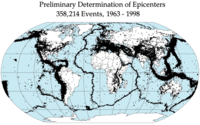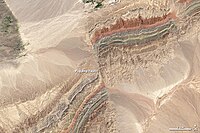
Decadal Modulation of Repeating Slow Slip Event Activity in the Southwestern Ryukyu Arc Possibly Driven by Rifting Episodes at the Okinawa Trough
Sign Up to like & getrecommendations! Published in 2017 at "Geophysical Research Letters"
DOI: 10.1002/2017gl074455
Abstract: We studied 38 slow slip events (SSEs) in 1997-2016 beneath the Iriomote Island, southwestern Ryukyu Arc, Japan, using continuous Global Navigation Satellite System (GNSS) data. These SSEs occur biannually on the same fault patch at… read more here.
Keywords: slip; ryukyu arc; okinawa trough; southwestern ryukyu ... See more keywords

Revisiting Slow Slip Events occurrence in Boso Peninsula, Japan, combining GPS data and Repeating Earthquakes analysis.: Revisiting Slow Slip Events history.
Sign Up to like & getrecommendations! Published in 2017 at "Journal of Geophysical Research"
DOI: 10.1002/2017jb014469
Abstract: Slow slip events (SSEs) regularly occur near the Boso Peninsula, central Japan. Their time of recurrence has been decreasing from 6.4 to 2.2 years from 1996 to 2014. It is important to better constrain the… read more here.
Keywords: revisiting slow; repeating earthquakes; boso peninsula; slip events ... See more keywords

An image segmentation based algorithm for imaging of slow slip earthquakes
Sign Up to like & getrecommendations! Published in 2018 at "Geodesy and Geodynamics"
DOI: 10.1016/j.geog.2018.04.001
Abstract: Abstract Laboratory experiments next to a variety of observations, especially in subduction zones, have explored the existence of a premonitory stable slow slip growth phase preceding large earthquakes. These phenomena play an important role in… read more here.
Keywords: uncertainty propagation; slip; slow slip; image segmentation ... See more keywords

Recurrent slow slip events as a barrier to the northward rupture propagation of the 2016 Pedernales earthquake (Central Ecuador)
Sign Up to like & getrecommendations! Published in 2017 at "Tectonophysics"
DOI: 10.1016/j.tecto.2017.12.012
Abstract: The northern Ecuador segment of the Nazca/South America subduction zone shows spatially heterogeneous interseismic coupling. Two highly coupled zones (0.4° S–0.35° N and 0.8° N–4.0° N) are separated by a low coupled area, hereafter referred… read more here.
Keywords: slip; pedernales earthquake; 2016 pedernales; ecuador ... See more keywords

Anisotropic viscoplasticity explains slow-slip M-T scaling at convergent plate margins
Sign Up to like & getrecommendations! Published in 2019 at "Tectonophysics"
DOI: 10.1016/j.tecto.2018.11.019
Abstract: Abstract In this study, we quantify the mechanisms that govern two related observations with regard to deep (15–50 km) subduction-zone aseismic slow-slip events (SSEs): (i) the linear scaling relationship between seismic moments (M0) and event durations… read more here.
Keywords: slip; dip parallel; rupture; slow slip ... See more keywords

Inherited State of Stress as a Key Factor Controlling Slip and Slip Mode: Inference From the Study of a Slow Slip Event in the Longitudinal Valley, Taiwan
Sign Up to like & getrecommendations! Published in 2021 at "Geophysical Research Letters"
DOI: 10.1029/2020gl090278
Abstract: Using borehole strainmeters, we detected a 13‐day long slow slip event in 2011 with Mw = 5.45 on the Longitudinal Valley Fault, Taiwan. It has been likely promoted by the significant Coulomb stress changes (∼0.5–1… read more here.
Keywords: slip; slip event; stress; slow slip ... See more keywords

Precursory Slow Slip and Foreshocks on Rough Faults
Sign Up to like & getrecommendations! Published in 2021 at "Journal of Geophysical Research"
DOI: 10.1029/2020jb020430
Abstract: Foreshocks are not uncommon prior to large earthquakes, but their physical mechanism controversial. Two interpretations have been put forward: 1. foreshocks are driven by aseismic nucleation; 2. foreshocks are cascades, with each event triggered by… read more here.
Keywords: slip; rough faults; stress; slip foreshocks ... See more keywords

Slip-rate-dependent friction as a universal mechanism for slow slip events
Sign Up to like & getrecommendations! Published in 2020 at "Nature Geoscience"
DOI: 10.1038/s41561-020-0627-9
Abstract: A growing body of observations worldwide has documented fault slip transients that radiate little or no seismic energy. The mechanisms that govern these slow slip events (SSEs) and their wide range of depths, slip rates,… read more here.
Keywords: slip; rate dependent; friction; rate ... See more keywords

Uncovering the physical controls of deep subduction zone slow slip using supervised classification of subducting plate features
Sign Up to like & getrecommendations! Published in 2020 at "Geophysical Journal International"
DOI: 10.1093/gji/ggaa285
Abstract: Deep slow slip events (SSEs) at subduction zones have significantly contributed to refining our understanding of the megathrust earthquake cycle at the brittle-ductile transition. However, the specific combination of factors that determine their occurrence has… read more here.
Keywords: term sse; term; subducting plate; plate ... See more keywords

Laboratory slow slip events in natural geological materials
Sign Up to like & getrecommendations! Published in 2019 at "Geophysical Journal International"
DOI: 10.1093/gji/ggz143
Abstract: S U M M A R Y Slow slip events (SSEs) and other forms of slow and transient fault slip are becoming increasingly recognized as important, due to their influence on seismicity and potential to… read more here.
Keywords: slip; velocity; slip events; friction ... See more keywords

Fluid pressure and shear zone development over the locked to slow slip region in Cascadia
Sign Up to like & getrecommendations! Published in 2018 at "Science Advances"
DOI: 10.1126/sciadv.aar2982
Abstract: Seismic data collected at the Cascadia subduction zone illuminate seismic structure across the locked to slow slip transition. At subduction zones, the deep seismogenic transition from a frictionally locked to steady sliding interface is thought… read more here.
Keywords: slip; shear zone; locked slow; slow slip ... See more keywords